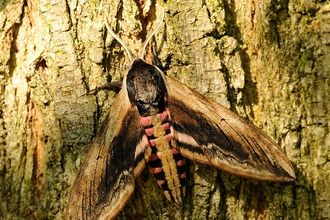Death's-head hawk-moth © Lauren Hibbert
Death's-head hawk-moth
This unmistakeable moth, famous for its skull-shaped marking, is a rare visitor to the UK.
Scientific name
Acherontia atroposWhen to see
Mostly August to OctoberSpecies information
Category
Statistics
Forewing length: 52-60 mmConservation status
Uncommon immigrant
Habitats
About
The death's-head hawk-moth is the largest moth to be found in the UK, with a whopping wingspan of around 120 millimetres. It is an immigrant from southern Europe, usually arriving in late summer or autumn. Small numbers are recorded each year, with occasional influxes producing dozens of records.Many records are of adults attracted to lights, though they are sometimes found in beehives where they feed on honey. Sometimes caterpillars can also be found, particularly around potato plants. They pupate in the ground, but are generally unable to survive winter in the UK.
When they feel threatened, the adult moths can make a squeaking sound by expelling air through their proboscis - their version of a tongue. It has a structure that vibrates, a bit like the reed of a saxophone or other wind instrument.
How to identify
Adult moths are huge and unmistakeable. The forewings are dark and velvety, with darker cross lines and several pale or reddish markings. The top of the body (thorax) is dark with a pale, skull-shaped marking. The abdomen and underwings are bright yellow with black lines across them.Caterpillars are also large, growing to over 100 mm. They can vary in colour, but fully grown caterpillars are usually yellow with blue diagonal stripes, or brown with grey stripes. They have a tail or 'horn' at the end of the body, which has a rough, bobbly surface.



